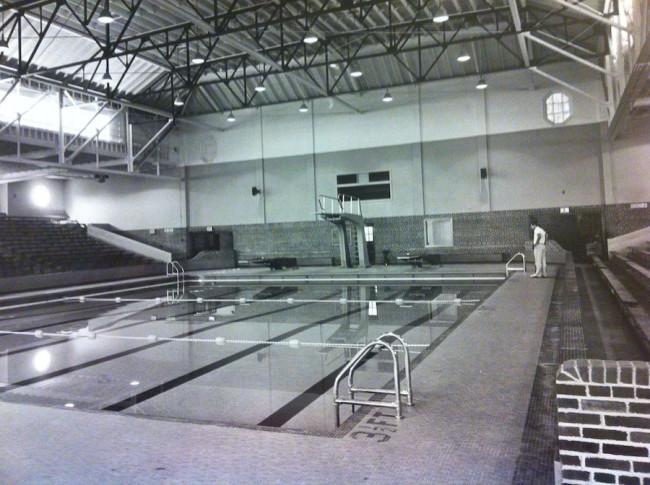The day was Dec. 2, 1972. Perkins Natatorium was packed. The SMU Men’s Swim Team competed against the University of Southern California.
SMU first-year Eddie Sinnott prepared to be the first member to swim in the team medley race.
“I was very much not prepared for a crowd of a 2,000 member student body and to swim with seven Olympians,” said Sinnott, now the head coach for the Men’s Swim team.
Before it was a natatorium, the building was used by the basketball team.
A basketball pavilion was first built on this site in 1926. It stood until 1948 when Joe J. Perkins and his wife Lois gave funds for the Joe. J. Perkins Gymnasium. The Perkins’ funded other buildings on campus including Perkins Chapel, the Perkins School of Theology, Perkins Administration building and some libraries. The gymnasium housed the Men’s Basketball team, athletic offices and hosted events including Commencement.
In 1957, the building underwent a $100,000 renovation, including an Olympic-sized pool, to become the home of the Men’s Swimming and Diving team. The name changed to the Joe J. Perkins Natatorium.
At the same time it became the home of the Men’s Swim team, the Mustang Band moved into the new band hall in the natatorium’s basement.
Today, the natatorium is under demolition because it was found to be unsafe. The building was closed to students and the public on March 30. The swim team is now practicing at the Barr Pool.
The basketball years
Before basketball coach Larry Brown became a favorite among Dallasites, there was the name E.O. “Doc” Hayes.
Hayes coached the Mustangs for 20 seasons from 1947-1967. He holds the record with the most wins for a SMU basketball coach at 299. Hayes led the Mustangs to the 1956 Final Four.
The 1955-1956 basketball season was one for the record books. The team included Bob McGregor, Bobby Mills, Jim Krebs, Rick Herrscher, Ned Duncan and Larry Showalter.
Not only did the Mustangs cause the University of Arkansas lose its first conference title. The team beat TCU in a historic game.
Jan. 28, 1956. Within the first seven minutes of the second-half, SMU scored 28 points. The team went on to win 105-64. It was the third time the Mustangs scored more than 100 points.
The Dallas Morning News’ “History on The Hilltop” website quotes point-guard Mills: “I’m not sure we had aspirations of doing anything more than winning the SWC before the season. But at some point, we realized we had a shot at the whole thing.”
In 1957, the Basketball team moved into Moody Coliseum. However, the victorious spirit did not leave the building.
Swim team takes over
The swim team moved into the reconstructed building in 1957. The team produced national champions and Olympians like Steve Lundquist, Ricardo Prado, Ronnie Mills and Rich Saeger.
The Mustangs won gold medals back-to-back in the Olympics. In the Summer 1996 games, Ryan Berube won on the USA 800 free relay team. Lars Frolander took home to gold in the 100 butterfly at the Summer 2000 games. Frolander became the fourth Mustang to win a gold medal at the Olympics.
Sinnott coached Berube and Frolander when they were students.
Sinnott is starting his 26th season as head coach this year. Under his leadership, he has lead SMU to 237 conference champion titles, coached 10 Olympians, 337 All-Americans.
Sinnott was the US Olympic team assistant coach in summer 2008 and the Haitian Olympic team head coach in 1996. Most recently, the team placed second at the first American Athletic Conference Championship and 20th at the 2014 NCAA Championship.
Music in the air
The band moved into the basement of the building at the same time the swim team arrived. Mustang Band Director Don Hopkins has many memories of Perkins Natatorium. As a student at SMU in the early 1980s, Hopkins was a member of the band. He still remembers walking into the band hall and seeing former Band Director Ivan Dreibrodt.
“Quite often Dr. Dreibrodt was leaning back in his chair smoking his Dunhill cigarettes,” he said.
Originally, the Mustang Band played jazz music. The music tradition came back in 1958 thanks to Dreibrodt, who became the band director in 1958. He created a new spirit group within the band called the “The Fightin’ Forty.” The spirit group was nicked named “the Hub of SMU Spirit.”
After SMU beat Oklahoma in the Bluebonnet Bowl in the 1968-1969 season, the band was named as the best half-time band in the nation by CBS. The band’s “The Highroad on the Hilltop” album made it to the second qualifying round of the 1998 Grammy Awards.
A tradition of the band is to sing “Varsity” after sporting events.
Tommy Tucker, the band’s assistant director, graduated SMU in 1984 and returned in 1996. His first memory of “Varsity” was as a freshman rehearsing in the band hall.
“It was such a wonderful sound to hear the male harmony,” said Tucker.









